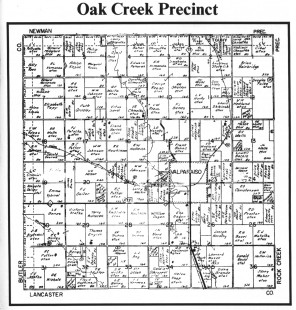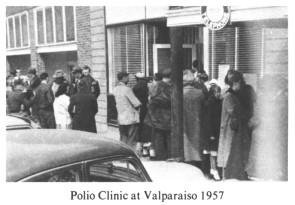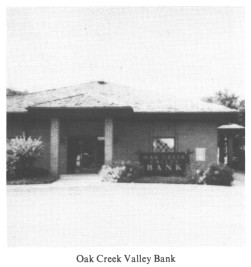 |
OAK CREEK PRECINCT |
 |
| (image links to larger map) |
|
Grand Island and Omaha via Valparaiso. (Numbers 27 and 28 were later taken for main line trains) No. 27 came out of Omaha about 2:00 p.m. and arrived in Valparaiso about 4:00 p.m. and into Grand island about 6:30 p.m. No. 28 came out of Grand Island at 6:00 a.m. and arrived in Valparaiso at 9:00 a.m. and into Omaha at 11:30 a.m. These passenger train engines were 1322 and 1326 class. Passenger trains No's. 137 and 138 ran between Omaha and Kansas City, Missouri via Valparaiso. No. 137 came out of Omaha at 7:00 a.m. and No. 138 came out of Kansas City and would arrive in Omaha at 6:00 p.m. They used a small class 2800 passenger engine. A steam engine powered train came out of Beatrice or Lincoln and ran through Valparaiso in the morning to Central City and back to Lincoln or Beatrice in the afternoon. The steam powered engine and passenger cars were replaced by a diesel powered "bug" passenger car. The UPRR controlled the switching yards in Omaha and by spotting their cars a day earlier than other line's cars they were able to run a freight train out of Kansas City to Omaha and back every day. The UPRR management seemed to be especially interested in this train and built up this branch line to accommodate this train which often carried as many as one hundred freight cars to a train. This is only an outline of the story, or history and drama, of the UPRR running trains through Valparaiso during this period of time. There is much, much more to the story of railroading through Valparaiso. Here is one such interesting side light. President Franklin Delano Roosevelt, during World War II spent a night on a special train on a siding in Valparaiso. The President's train came into Valparaiso during the night where it was serviced. Soldiers were everywhere guarding every switch, building and every possible hiding place. They were spread out along the track within hailing distance of each other all the way to Omaha. The president's train did not stop at the Mead Bomb Loading Plant, but it was assumed that he visited the area while in Valparaiso. by Archie McMaster
OAK CREEK VALLEY BANKOn March 4, 1899, in Valparaiso, Nebraska, the Oak Creek Valley Bank, Inc. was authorized to transact the business of a Commercial Bank as provided in the Banking Act of the State of Nebraska approved on April 8, 1895. It received the charter number 522, having authorized capital stock of $50,000.00, of which $10,000.00 was paid in. Previous to becoming a corporation, Oak Creek Valley Bank was a private bank owned by H. Bleakley, President, and O.C. Bleakley as Assistant Cashier. It opened in 1891 with the charter number 432 and a capital stock of $10,000.00. In 1897, H. Bleakley became the cashier and sole owner of the bank. Competition was offered on a local level when in 1906 another bank opened its doors. It was named the Valparaiso State Bank and was also operated by H. Bleakley. Growth was made by both banks over the years up until the 1920's, when the Oak Creek Valley Bank pulled ahead to become the stronger of the two. Then the depression, bad times and 1930 came along. Both banks closed their doors, with the Nebraska State Bank (formerly the Valparaiso State Bank) never to re-open. The Oak Creek Valley Bank, closed its doors on March 15, 1930, but was re-organized under statute 8-181 (HR 249) and re-opened on July 26, 1930, with new officers and new directors. Its re-opening statement was $127,628.68 and the officers were James W. Pokorny, president, R.E. Novak, cashier and J.V. Roh, assistant cashier. The first board of directors of the newly reorganized bank consisted of mainly J.W. Pokorny, B.G. Gerdes, E.E. Placek, B.E. Hendricks and R.E. Novak. With the beginning of a new decade, the Oak Creek Valley Bank once again saw change. In January of 1960, A.S. "Chico" Chaves and Eldon G. Freudenburg became the new owners. Banking was nothing new to these two as Mr. Chaves of Lincoln had been a former National Bank Examiner and had worked in both Stockyards National Bank of Omaha and First National Bank and Trust Company of Lincoln. Mr. Freudenburg of West Point, Nebraska (now currently residing in Estes Park, Colorado) had been associated with Mr. Chaves when they had owned a bank in Clarkson, Nebraska. The board of directors in 1960 had also undergone a change as it now consisted of A.S. Chaves serving as Chairman; Eldon G. Freudenburg; Earl Adams, a prominent Valparaiso resident; Clyde Worrall, an attorney from Wahoo Nebraska; and managing officer, Glen D. Maxson. In 1961, James T. Margrave, whose previous experience in the banking field included the Wahoo State Bank and St. Mary's in Idaho, became the new managing officer. The year 1963 saw a change in managing officers once again when James C. Barry of Valparaiso, who was presently employed at the bank, assumed this position. The bank's ownership remained the same until 1975 when Mr. Chaves sold out his shares to the other directors, and retired to Arizona where he died a year later. Mr. Freudenburg became the majority owner and chairman of the board. The other directors were Dennis Siedel, an officer with the Oak Creek Valley Bank and Valparaiso resident who replaced Mr. Chaves; Mr. William R. Wright, a Lincoln attorney who replaced Clyde Worrall; Earl Adams; and John C. Barry. The Board would see one more change with the death of Earl Adams in August of 1982. Mr. Adams had served on the board for over forty years and a plaque and photo now hang in the Oak Creek Valley Bank commemorating his service. Mr. Gene C. Eaton, a Lincoln resident and businessman, was chosen to replace Mr. Adams. Due to the tremendous growth of the bank the original building became too small and a new facility was constructed. The new building was opened for its first business day on March 31, 1980, and is located two blocks east of the old one. The former bank building was donated to the town and the Valparaiso Public Library now occupies the site. Submitted by John C. Barry. OAK VALLEY GRANGEThe Oak Valley Grange was organized at Valparaiso June 15, 1950 -- Edward Schoen, Anton Komenda and James Martin were its first officers, this farm organization held their meetings monthly. Records show 42 Charter Members, in 1951 records show a class of 23 members taking the 4th degree and joining the Grange. In 1951 the members entered a State project of terrace building taking third place in the State Project, prizes were by the Sears Roebuck Foundation. The Grange continued on with these kinds of Projects, also Sewing, dress making and baking. The juveniles also organized, their ages, 12 to 18 years. As these were the years of the Polio epidemic, vaccine was made available to combat same, the Grange appointed a committee to plan for a mass innoculation with Federally funded Vaccine for Children under 20 years of age, some vaccine was also to be available for expectant mothers and a few other adults. This Committee with the cooperation of local people and the son (Lou Schoen) of chairman of the Committee were much help in getting this project under way. Lou was a graduate of the University of Nebr. who did most of the foot work in obtaining a Doctor John W. Rogers of Lincoln under whose direction the vaccine was ordered and administered, assisted by volunteer nurses, Mrs. Francis Barry, Mrs. Mary Voboril and Karen Scott all of Valparaiso. Syringes, needles, vaccine and other equipment used were from stocks purchased by the State Health Department and the National Foundation for Infantile Paralysis. The first Clinic was held Saturday, April 13, 1957 -- when 292 children, 66 adults received shots! The second Clinic was held Saturday, May 18, 1957 -- when 206 children, 6 expectant mothers and 80 adults were innoculated. Nurses were Mrs. Francis Barry, Karen Scott, assisting them was Mrs. Clarence Christensen, Jr., Mrs. Jennie Tucker helped with the registrations, these people also helped with the last innoculation held Jan. 11, 1958 -- when 218 children, 4 expectant mothers and 88 adults received the Polio Vaccine at a cost of .35 cents per shot for children and expectant mothers, $1.35 per shot for other adults. A total of 960 receiving Polio Vaccine from five counties, Lancaster, Seward, Butler, Otoe and Saunders county. Innoculation was held in St. Mary's Hall in Valparaiso, thanks to these fine church people. After 16 years all interest in a Grange was lost and the organization abandoned. By Ed Schoen VALPARAISO COMMUNITY CLUBThe Valparaiso Community Club was formed for the purpose of sponsoring programs to better the community and the people in it. Past projects of the club were: tree plantings at the new park, a drug abuse program, and a drive for a new ball park. The 1982 officers were: David Barry, Nels Nelson, Charlene Gerdes, Bob Schmucker. In February, 1982, the Valparaiso residents honored the OUTSTANDING CITIZEN (Robert Lindholm, a 43-year veteran of the Valparaiso Volunteer Fire Department). This event was sponsored by the Valparaiso Community Club. MRS. JAYCEESThe Mrs. Jaycees was an active organization in 1976 in Valparaiso. In November, 1976, we found the women making plans for a Christmas Party. INTERNATIONAL 4-H YOUTH |
| Back | Contents | Next |
The Saunders County NEGenWeb Project

